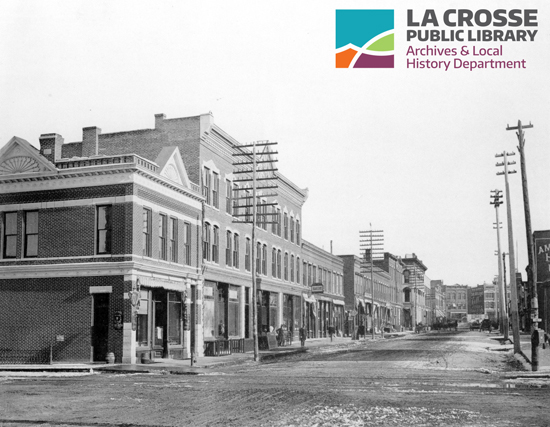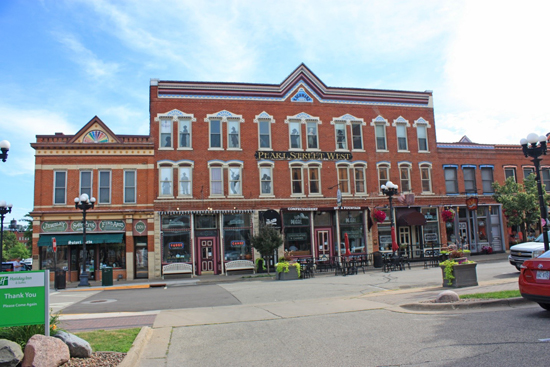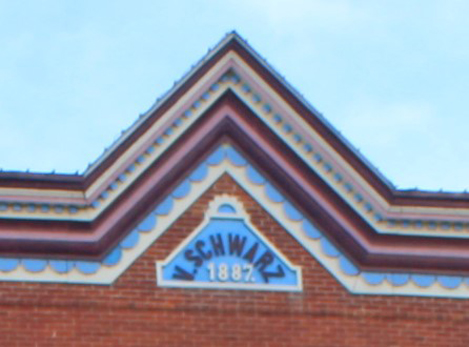
Neighbors Making History: Vincent Schwarz - Klondike Fever
(written by Jeff Rand, retired Adult Services librarian)
When one hears the word “Klondike” now, the first thing that probably comes to mind, especially at this time of year, is the brand name of delicious ice cream treats. In the late 1890s, however, Klondike meant something entirely different - gold.

"Last evening on the westbound Milwaukee train Mr. and Mrs. Vincent Schwartz and their seven children of this city left for the Klondike, where they will make their future home. About two years ago Mr. Schwartz became a victim of gold fever and went to the Klondike. He staked out five claims and in a short time realized handsomely on his diggings. Finding that five claims were too much to work he disposed of three of them, and leaving the other two in charge of an old prospector, he returned to La Crosse for his wife and family. Mr. Schwartz has built a comfortable home on one of his claims, and expects to live there until he secures an independent fortune." (La Crosse Daily Press, 1 May 1901)
Vincent Schwarz (also spelled Schwartz in some sources) was born in Württemberg, Germany, in September 1846. He came to the United States in 1855 when he was nine years old with his parents, John and Marthina (or Martina). Another son, Joseph, was born in New York about four years after they arrived in the United States.
The Schwarz family shows up in the 1866 La Crosse City Directory living at 804 King Street, Vincent included. Vincent does not show up in the La Crosse city directories covering 1868 through 1876, nor in the 1870 U.S. Federal Census for La Crosse. There is, however, a 23-year-old Vincent Schwarz, who was born in Wurttemberg, Germany, attending a newly-opened college in 1870 in St. Cloud, Minnesota, that would later become St. Cloud State University.
Schwarz appears to have been a grocer in La Crosse in 1878 before becoming a furniture dealer two years later. His furniture store was on the north side of Pearl Street. The 1881 city directory shows Schwarz also working as an upholsterer on the north side of State Street between 2nd and 3rd streets. He and his brother, Joseph, lived with their parents at 66 Winnebago Street. Most of this block on 9th Street between Winnebago and Mississippi streets is now occupied by the Mathy Center and the Varsity Athletics Center of Viterbo University. By 1884, Vincent had moved out of his parents' home and from 1884-1897, Schwarz operated a used furniture store in the 200 block of Pearl Street. This building bears his name and is the current home of The Pearl Ice Cream Parlor.

West end of Pearl Street, looking east, in 1897

Looking north at the same building on the west end of Pearl Street. Photo taken by the author, 2022

The ornamentation at the peak of the building indicates that it was built by “V. Schwarz” in 1887
Schwarz was 42 years old when he married 26-year-old Bertha Lenz on September 13, 1888, in Waumandee, Wisconsin. From limited documentation, it appears that Bertha had two daughters from a previous marriage and they had a son together by the time they got married. They would have six more children before 1900---three sons and three daughters.
In 1897, Vincent Schwarz had an established furniture business and a family with nine children to support. During the previous year, events occurring thousands of miles away would soon affect their lives, as well as the lives of thousands of others.
In August 1896, a Canadian, Robert Henderson, and an American, George Washington Carmack, independently found gold on branches of the Klondike River in the Yukon region of northwest Canada. Carmack bragged about his discovery, and soon dozens of prospectors flocked to the area. When 150 people returned to Seattle on a steamship in October of that year, after spending the season panning for gold in the Yukon, they brought with them $200,000 worth of gold dust and nuggets.
Jack Carr also helped ignite the Klondike gold rush on July 11, 1897, when he rode into Juneau, Alaska, on a dogsled with news of a mother lode of gold near Dawson, at the junction of the Yukon and Klondike rivers, in Canada. The following week, ships arrived in Seattle and San Francisco carrying successful prospectors and tons of gold. Forty gold prospectors disembarked from a steamship at San Francisco carrying over $500,000 worth of gold dust in buckskin bags, glass fruit jars, and jelly jars. There was another $250,000 brought in by the Alaska Commercial Company on the same ship. An official with the ACC wrote in a letter:
The excitement on the river is indescribable, and the output of the new Klondike district is almost beyond belief. Men who had nothing last fall are now worth a fortune. One man has worked forty square feet of his claim and is going out with $40,000 in dust. One-quarter of the claims are now selling at from $15,000 to $50,000. The estimate of the district is given as thirteen square miles, with an average of $300,000 to the claim, while some are valued as high as $1,000,000 each.
“The New El-Dorado. The Canadian Yukon Marvellously (sic) Rich in Gold”
(The Gazette of Montreal, Quebec, Canada)
“Never in modern history have tales so wonderful of rich gold discoveries been told...”
(Olathe News of Olathe, Kansas)
“The Placer Mining in Alaska is the Richest the World Has Ever Known”
(Vermont Phoenix of Brattleboro, Vermont)
“Gold Dust as Common as Sawdust”
(The Dayton Herald of Dayton, Ohio)
Seattle was the jumping off point for many of the gold seekers from all over the world. Trains from all parts of the United States were arriving every day with hundreds of men and women eager to seek their fortunes in northwest Canada and Alaska. Merchants scrambled to provide supplies and provisions for the would-be gold miners. Newspaperman E. Hazard Wells wrote in late mid-1897, “Alaska outfitting seems to be the sole business of this city at present.”
According to the National Park Service, 90% of the Klondikers used the Seattle to Skagway to Dawson City trail because it was the most direct route to the gold fields.
Steamships were the primary means of transportation from Seattle to Skagway, Alaska. Ship fares rose to as high as $1,000. For many, this could be a perilous journey in rolling seas while keeping a lookout for icebergs. One, two, or three steamships docked at Skagway every day to unload their passengers and supplies. Some ships could not even return because their crews deserted to join the gold prospectors.
Everyone’s objective was the junction of the Yukon and Klondike rivers in British Columbia where the towns of Klondike City and Dawson sat in the bullseye of the Klondike Mining District, 550 miles away through untamed wilderness. The prospective prospectors had to haul (by pack animal, boat, and muscle power) food, gear, and other supplies into a trackless wilderness dotted with glaciers, forests, swamps, mountains, and wild rivers. Often, they had to cut their own trails, building bridges and laying down logs to make corduroy roads along the way. They built makeshift boats to use on the rivers and lakes. It was a landscape that challenged, and sometimes devoured, greenhorn adventurers. One Klondiker from Indiana wrote home: “I am undoubtedly a crazy fool for being here in this God-forsaken country but I have the consolation of seeing thousands of other men in all stages of life, rich and poor, wise and foolish, here in the same plight as I.”
Thousands became demoralized by the brutal work in an unforgiving environment, and they turned back to Skagway before even reaching the Yukon gold fields. Over 100,000 people tried to reach the land of not-so-instant riches, but only 30,000 to 40,000 were able to set foot in Alaska and the Klondike Territories. Those who persevered had to build cabins and mining facilities on their claims before the brutal winter. Much of this was done in the summer heat that could reach 100 degrees while being tormented by swarms of mosquitoes. Any outside activity in the winter meant slogging through feet of snow in temperatures as low as 60 degrees below zero. Mining continued in the winter, but the miners had to light fires in the mine shafts that would burn all night just to thaw seven to 15 inches of the soil. Once that thawed earth was removed, another fire would be kindled to thaw the next layer.
By late September 1897, newspaperman E. Hazard Wells wrote that there were 6,000 to 8,000 men working 1,200 gold claims in the Klondike country. He said 2,000 more men were enroute along the Yukon River. Dawson, on the north bank of the Klondike River, became a facsimile of a boom town in the American West. At the end of November 1897, Wells penned this description:
Dawson has fully thirty saloons, none of them licensed, but all “permitted” despite the law; two barbershops, which charge 50 cents for a shave and $1 for a haircut; one incipient public library, just forming; two big stores---the A. C. [Alaska Commercial Company] and the N.A.T. and T. [North American Trading and Transportation Company] companies; several smaller stores; one meat market, where beefsteaks retail at $4.50 each; two dance halls, for disreputable females and forgetful husbands away from their wives; two sawmills; an uncounted number of lawyers, brokers, etc.; two jewelry shops; three secondhand establishments; one blacksmith shop; one tin shop, earning $100 profit per day; one public hall (Pioneers) [fraternal organization]; three missionaries and 235 gamblers.
By July 1898, Dawson had exploded into a city of 40,000.
The Klondike Gold Rush had already climaxed by the time 52-year-old Vincent Schwarz left La Crosse in 1899 to try his hand at gold mining. Those who got there first had already claimed the most promising spots, and there were still thousands of men futilely seeking their own gold claim. He apparently did well enough to leave the furniture business and move his family to the Klondike two years later. The 1900 census shows Vincent’s occupation as “miner.”
We do not know how much gold the Schwarz family found in the Klondike. We do know that their sojourn in the far north was less than a decade. In 1910, Vincent and Bertha, along with seven of their nine children, were living in Seattle, Washington. Vincent was again working as a cabinet maker. By 1920, Bertha Schwarz and five of her children were living on 41st Street in Seattle. Vincent is not listed in the household.
When Seattle celebrated the 25th anniversary of the Klondike Gold Rush in July 1922, there was a parade, fireworks show, and carnival. The two-mile-long parade featured hundreds of men and women who had gone north seeking gold. Vincent Schwarz, then 75 years old, won first place for best “sourdough” costume. The bearded Schwarz “carried the same pack, tools, and cooking utensils” that he had during his gold prospecting days. He was described “as a crowd-pleaser and received applause throughout the entire parade route.”
On August 2, 1924, Vincent Schwarz sat in the window of the Seaboard Bank in Seattle panning for gold with dirt sent from Alaska by millionaire businessman Austin E. Lathrop. The stunt was promotion for the premiere of the movie The Chechackos in Seattle’s Liberty Theater.
Bertha Schwarz, Vincent’s wife, died of stomach cancer on October 14, 1926, in Tacoma, Washington, at the age of 62. Vincent Schwarz was 80 years old when he died on January 28, 1927, in the Northern State Hospital at Sedro Woolley, Washington, after suffering from psychosis and senile dementia for almost nine months.
Of the estimated 100,000 people who made the trip to the frozen north in search of their fortune, only a few hundred struck it rich. There was not enough gold to go around, and the Klondike gold rush slowed to a crawl in just three years. Dawson shrank to a village of 1,000. Only 10 percent of those who had reached Dawson City in 1898 found any gold. Many others profited from the $60 million spent on transportation, supplies, and gear by potential prospectors.
Will Langille, a Klondiker from Oregon, wrote in a letter home, “I never saw men work harder, bear more and accomplish less.” The danger and hardships of trail and camp in the Yukon were the price of admission to a fraternity of men and women, “the Klondikers,” who journeyed to the end of the rainbow seeking a pot of gold. And Vincent Schwarz, a middle-aged used furniture dealer from La Crosse, was one of them.
WANT TO LEARN MORE?
Check out Jeff's full article here

